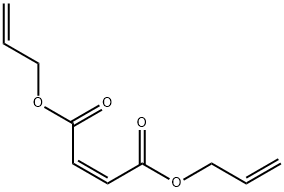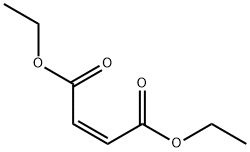Diallyl maleate
- CAS NO.:999-21-3
- Empirical Formula: C10H12O4
- Molecular Weight: 196.2
- MDL number: MFCD00010763
- EINECS: 213-658-0
- Update Date: 2024-12-18 14:07:02

What is Diallyl maleate?
Chemical properties
colorless liquid with a pungent odor.
The Uses of Diallyl maleate
Diallyl maleate has potential applications in polyester resins, adhesives, and ion exchange resins. When used at low levels, Diallyl Maleate is an effective agent for the promotion of branching in emulsion polymers.
The Uses of Diallyl maleate
An agent for the promotion of branching in emulsion polymers
What are the applications of Application
Diallyl maleate is an agent for the promotion of branching in emulsion polymers
Preparation
Diallyl maleate is obtained by the sulfuric acid-catalyzed esterification of maleic anhydride with propyl alcohol.
Safety Profile
Poison by ingestion and intraperitoneal routes. Moderately toxic by skin contact. A skin and eye irritant. When heated to decomposition it emits acrid smoke and irritating fumes. See also ALLYL COMPOUNDS and ESTERS.
Properties of Diallyl maleate
| Melting point: | −47 °C(lit.) |
| Boiling point: | 106-116 °C4 mm Hg |
| Density | 1.074 g/mL at 20 °C(lit.) |
| vapor density | 6.6 (vs air) |
| vapor pressure | 4 mm Hg ( 25 °C) |
| refractive index | n |
| Flash point: | >230 °F |
| storage temp. | 2-8°C |
| form | clear liquid |
| color | Colorless to Almost colorless |
| Odor | pungent odor |
| Water Solubility | Soluble in water 151.2 mg/L @ 25°C. |
| BRN | 1725954 |
| CAS DataBase Reference | 999-21-3(CAS DataBase Reference) |
| EPA Substance Registry System | Diallyl maleate (999-21-3) |
Safety information for Diallyl maleate
| Signal word | Danger |
| Pictogram(s) |
 Skull and Crossbones Acute Toxicity GHS06 |
| GHS Hazard Statements |
H301:Acute toxicity,oral H312:Acute toxicity,dermal H315:Skin corrosion/irritation H319:Serious eye damage/eye irritation H335:Specific target organ toxicity, single exposure;Respiratory tract irritation |
| Precautionary Statement Codes |
P280:Wear protective gloves/protective clothing/eye protection/face protection. P305+P351+P338:IF IN EYES: Rinse cautiously with water for several minutes. Remove contact lenses, if present and easy to do. Continuerinsing. |
Computed Descriptors for Diallyl maleate
| InChIKey | ZPOLOEWJWXZUSP-WAYWQWQTSA-N |
Diallyl maleate manufacturer
Veekay Chemicals
1Y
Phone:+91-9821518903
Whatsapp: +91-9821518903
product: 999-21-3 Diallyl maleate 98%
Xena Organics Pvt Ltd
1Y
Phone:+919323593569
Whatsapp: +91- 9323593569
product: Diallyl maleate 999-21-3 98%
New Products
(S)-3-Aminobutanenitrile hydrochloride 4-Methylphenylacetic acid N-Boc-D-alaninol N-BOC-D/L-ALANINOL Tert-butyl bis(2-chloroethyl)carbamate N-octanoyl benzotriazole 3-Morpholino-1-(4-nitrophenyl)-5,6-dihydropyridin- 2(1H)-one Furan-2,5-Dicarboxylic Acid S-2-CHLORO PROPIONIC ACID ETHYL ISOCYANOACETATE 2-Bromo-1,3-Bis(Dimethylamino)Trimethinium Hexafluorophosphate 4-IODO BENZOIC ACID 3-NITRO-2-METHYL ANILINE 1-(2,4-DICHLOROPHENYL) ETHANAMINE (2-Hydroxyphenyl)acetonitrile 4-Bromopyrazole 5,6-Dimethoxyindanone 2-(Cyanocyclohexyl)acetic acid 4-methoxy-3,5-dinitropyridine 1-(4-(aminomethyl)benzyl)urea hydrochloride 2-aminopropyl benzoate hydrochloride diethyl 2-(2-((tertbutoxycarbonyl)amino) ethyl)malonate tert-butyl 4- (ureidomethyl)benzylcarbamate Ethyl-2-chloro((4-methoxyphenyl)hydrazono)acetateRelated products of tetrahydrofuran








You may like
-
 999-21-3 Diallyl maleate 98%View Details
999-21-3 Diallyl maleate 98%View Details
999-21-3 -
 Diallyl maleate 999-21-3 98%View Details
Diallyl maleate 999-21-3 98%View Details
999-21-3 -
 Diallyl maleate CAS 999-21-3View Details
Diallyl maleate CAS 999-21-3View Details
999-21-3 -
 Diallyl Maleate CAS 999-21-3View Details
Diallyl Maleate CAS 999-21-3View Details
999-21-3 -
 Diallyl maleate (stabilized with HQ) 98% (GC) CAS 999-21-3View Details
Diallyl maleate (stabilized with HQ) 98% (GC) CAS 999-21-3View Details
999-21-3 -
 Diallyl maleate CAS 999-21-3View Details
Diallyl maleate CAS 999-21-3View Details
999-21-3 -
 14714-50-2 (2-Hydroxyphenyl)acetonitrile 98+View Details
14714-50-2 (2-Hydroxyphenyl)acetonitrile 98+View Details
14714-50-2 -
 118753-70-1 98+View Details
118753-70-1 98+View Details
118753-70-1
Statement: All products displayed on this website are only used for non medical purposes such as industrial applications or scientific research, and cannot be used for clinical diagnosis or treatment of humans or animals. They are not medicinal or edible.